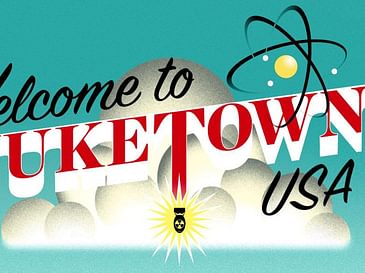On this episode of My Nuclear Life, host Shelly Lesher is joined by archivist Robert Franklin. Robert is an oral historian for Department of Energy’s Hanford Collection and also has the title of Assistant Director of Hanford History Project at Washington State University. He is passionate about preserving personal narratives of all people in the areas surrounding Hanford lab, and wrote a book called Nowhere to Remember all about the history of Hanford. Listen as he shares his knowledge and expertise on the history found in Hanford.
The podcast begins with Richard talking about Hanford’s role in the Manhattan Project, which was to produce the plutonium that was used to fuel some of the first atomic weapons used during WWII. Before this, Hanford was a very low populated, rural, agricultural area with farming as its main source of income. Even farming was a struggle because of the harsh environment there. People were brought in to work at the Hanford lab by the offer of high wages and food. Robert also explains how this was a top secret project, and therefore, the workers did not even know what they were creating and instead were simply told that it would help end the war. Additionally, the people who did work there were all heavily investigated to ensure full secrecy, and their aim was to stay out of the eyes of surrounding communities.
When the Hanford Lab was established, the government began to make appraisals on the land and force many farmers and locals to relocate. Many of these appraisals were very low which lead to lawsuits against the government. However, because of the poverty in the area, many people were not able to secure lawsuits and were simply forced to leave. Robert speaks about the Hanford-White Bluff Pioneer Association lead by Edmund Anderson, which was a group of people who worked to collect records, photographs, appraisals, and stories from people in the community about the Hanford Lab and the history of this community and the people in it. This history shows the abrupt end of this community and the jobs in agriculture along with the sacrifice these people made.
Next, the podcast moves on to Shelly asking Robert to share the history of the B Reactor. Robert shares about the size of this project and reactor along with the engineering that went into it. In fact, Robert explains how this was more of an engineering project in the creation of the building rather than a physicist project, and he takes some time to explain the engineering behind it. While the Hanford Lab and the B Reactor did not get as much attention in history, Robert shares how it was equally important to the many other projects in its creation of the assembly of plutonium which fueled some of the first atomic weapons. Additionally, Robert points out how this project remained classified until the publication of an autobiography written by General Groves which opened the door of uncovering its history.
Moving the conversation from Hanford’s past to its current history, Robert points out that Hanford is now part of the National Park Service. This began in the late 90’s when Hanford’s B Reactor Museum Association was created. This association was created to preserve the history of the Hanford area and the B Reactor, and their goal was to do this by turning the B Reactor into a museum. However, for this to be done, there were many different steps that had to be done to make it a safe place to tour. Going along with this, Robert also dives into the different research and information on the B Reactor, such as its process of making plutonium, how this and other reactors were built, the process created to help shield workers from radiation, and the effects of all the waste from this reactor and how this was treated later on.
Links:
- Learn more about Robert Franklin and follow him on LinkedIn.
- Nowhere to Remember: Hanford, White Bluffs, and Richland to 1943 (Hanford Histories) by Robert Bauman and Robert Franklin
- Hanford Site Tours
-Send an email to My Nuclear Life or visit their website.
-To sponsor My Nuclear Life and receive gifts, visit Patreon.com/nuclearlife.
Please leave a 5-star review on iTunes and subscribe to My Nuclear Life wherever you listen to podcasts!
Robert Franklin is the Archivist & Oral Historian of the Hanford History Project and Instructor of History at Washington State University Tri-Cities. He is the co-editor and author of two books on the Hanford area, Nowhere to Remember: Hanford, White Bluffs and Richland to 1943 and Echoes of Exclusion and Resistance: Voices from the Hanford Region.
Special thanks: Lexie Weghorn
Production costs for this episode were provided through National Science Foundation Grants PHY-1713816 & 2011267.





